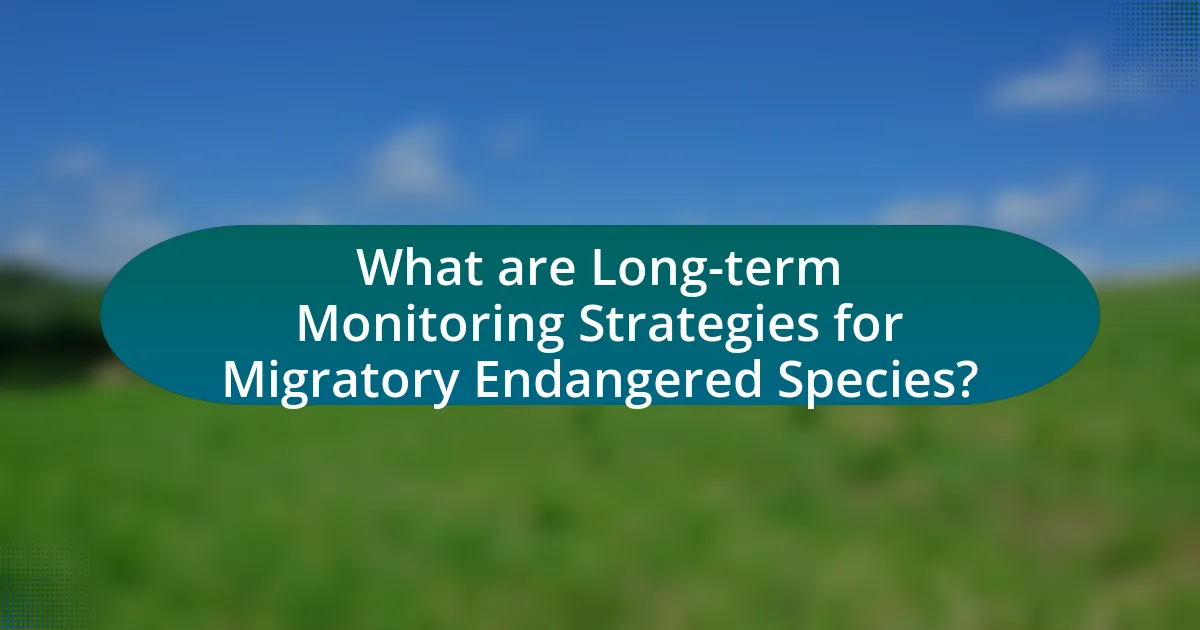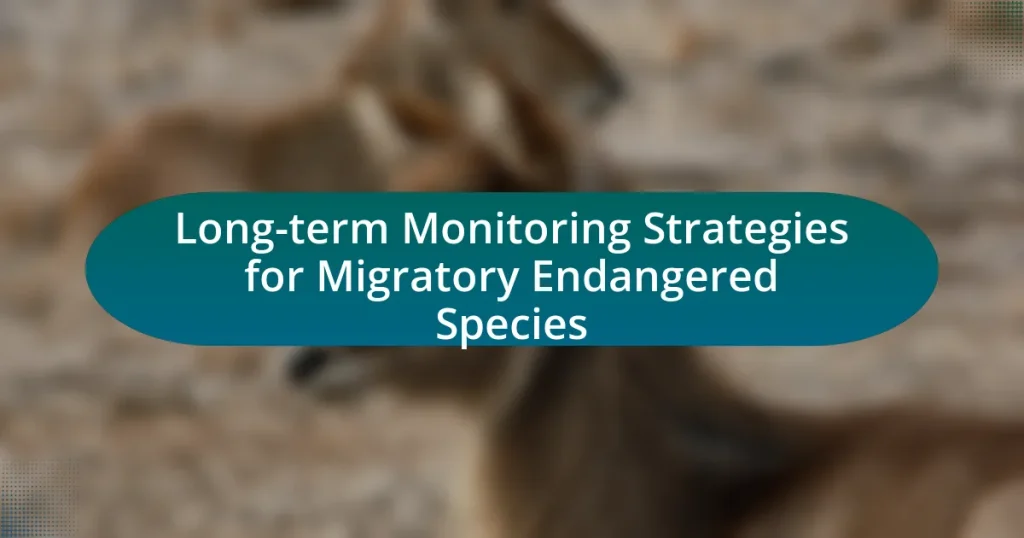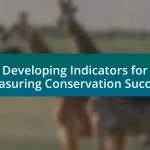Long-term monitoring strategies for migratory endangered species are critical for tracking population dynamics, habitat use, and migratory patterns. These strategies employ methods such as satellite telemetry, banding, and citizen science initiatives to gather essential data that informs conservation efforts. The article outlines the importance of continuous observation in identifying changes in migratory behaviors, assessing environmental impacts, and adapting management plans. It also discusses the challenges faced in monitoring, including logistical difficulties and funding constraints, while highlighting the role of technology and community engagement in enhancing data collection and analysis for effective conservation outcomes.

What are Long-term Monitoring Strategies for Migratory Endangered Species?
Long-term monitoring strategies for migratory endangered species include systematic tracking of population dynamics, habitat use, and migratory patterns through methods such as satellite telemetry, banding, and citizen science initiatives. These strategies are essential for understanding the ecological needs and threats faced by these species, enabling conservationists to implement effective management plans. For instance, satellite telemetry has been used to track the migration routes of species like the Arctic Tern, revealing critical stopover sites that require protection. Additionally, long-term data collection allows for the assessment of environmental changes and their impacts on migratory behaviors, which is crucial for adapting conservation efforts to ensure the survival of these vulnerable populations.
Why is long-term monitoring important for migratory endangered species?
Long-term monitoring is crucial for migratory endangered species because it provides essential data on population trends, habitat use, and threats over time. This continuous observation allows researchers to identify changes in migratory patterns and assess the effectiveness of conservation strategies. For instance, studies have shown that long-term data collection can reveal the impacts of climate change on migration routes, enabling targeted interventions. Additionally, monitoring can help detect early signs of population decline, which is vital for timely conservation actions.
What are the key objectives of long-term monitoring?
The key objectives of long-term monitoring are to assess population trends, evaluate habitat conditions, and inform conservation strategies for migratory endangered species. By systematically collecting data over extended periods, researchers can identify changes in species abundance and distribution, which are critical for understanding the effectiveness of conservation efforts. Additionally, monitoring habitat quality helps in recognizing environmental changes that may impact these species, thereby guiding management actions. Studies have shown that long-term data collection enhances the ability to detect ecological shifts and informs adaptive management practices, ultimately contributing to the preservation of biodiversity.
How does long-term monitoring contribute to conservation efforts?
Long-term monitoring significantly enhances conservation efforts by providing critical data on species populations, habitat conditions, and ecological trends over time. This continuous data collection allows conservationists to identify changes in migratory patterns, assess the effectiveness of conservation strategies, and make informed decisions based on empirical evidence. For instance, studies have shown that long-term monitoring of the California condor population has led to successful breeding programs and habitat restoration efforts, resulting in population increases from 27 individuals in 1987 to over 500 today. Such concrete examples demonstrate that sustained observation is essential for adapting conservation measures to ensure the survival of endangered species.
What challenges are faced in long-term monitoring of migratory endangered species?
Long-term monitoring of migratory endangered species faces several challenges, including logistical difficulties, funding constraints, and data collection inconsistencies. Logistical difficulties arise from the vast and often inaccessible habitats these species traverse, making it hard to track their movements accurately. Funding constraints limit the resources available for comprehensive monitoring programs, which are essential for gathering long-term data. Additionally, data collection inconsistencies can occur due to varying methodologies and technologies used across different regions, leading to gaps in information that hinder effective conservation efforts. These challenges complicate the ability to assess population trends and implement timely conservation actions.
What are the logistical challenges in monitoring migratory species?
Monitoring migratory species presents several logistical challenges, including the vast geographic ranges these species cover, which complicates data collection and tracking. The need for extensive fieldwork across diverse habitats often requires significant resources, including funding, personnel, and equipment. Additionally, the seasonal nature of migration can lead to timing issues, making it difficult to gather consistent data throughout the year. Weather conditions and accessibility to remote locations further hinder monitoring efforts. Furthermore, coordinating between multiple stakeholders, such as governments, NGOs, and local communities, adds complexity to the logistics of monitoring programs. These factors collectively create significant barriers to effective and comprehensive monitoring of migratory species.
How do environmental changes impact monitoring efforts?
Environmental changes significantly hinder monitoring efforts by altering habitats, affecting species behavior, and complicating data collection. For instance, climate change can shift migratory patterns of endangered species, making it difficult for researchers to track populations accurately. A study published in the journal “Ecological Applications” by Houghton et al. (2020) found that changes in temperature and precipitation patterns can lead to mismatches in timing between species and their food sources, further complicating monitoring efforts. Additionally, habitat destruction due to urbanization or agriculture can reduce the availability of sites for monitoring, leading to gaps in data that are crucial for conservation strategies.
What methodologies are used in long-term monitoring strategies?
Long-term monitoring strategies for migratory endangered species utilize methodologies such as telemetry, remote sensing, and population modeling. Telemetry involves tracking animal movements through GPS or radio signals, providing real-time data on migration patterns and habitat use. Remote sensing employs satellite imagery and aerial surveys to assess habitat changes and environmental conditions over time. Population modeling uses statistical techniques to estimate population sizes and trends, allowing researchers to predict future dynamics and inform conservation efforts. These methodologies are validated by studies demonstrating their effectiveness in tracking species like the whooping crane and the monarch butterfly, which have shown significant insights into their migratory behaviors and habitat requirements.
What role do technology and data collection play in monitoring?
Technology and data collection are essential for effective monitoring of migratory endangered species. They enable researchers to gather real-time data on species movements, habitat use, and population dynamics through tools such as GPS tracking, remote sensing, and automated data loggers. For instance, GPS collars provide precise location data, allowing scientists to analyze migration patterns and identify critical habitats. Additionally, data collection methods like camera traps and acoustic monitoring facilitate the assessment of species presence and behavior in various environments. These technological advancements enhance the accuracy and efficiency of monitoring efforts, ultimately supporting conservation strategies and informing policy decisions.
How are citizen science initiatives integrated into monitoring strategies?
Citizen science initiatives are integrated into monitoring strategies by actively involving the public in data collection and analysis, which enhances the breadth and depth of monitoring efforts. These initiatives leverage community engagement to gather large volumes of data on migratory patterns, population dynamics, and habitat conditions, which are critical for assessing the status of endangered species. For example, projects like the Audubon Society’s Christmas Bird Count utilize volunteers to report bird sightings, providing valuable data that informs conservation strategies. This collaborative approach not only increases data availability but also fosters public awareness and support for conservation efforts, ultimately contributing to more effective long-term monitoring of migratory endangered species.

How can data from long-term monitoring be utilized?
Data from long-term monitoring can be utilized to assess population trends, understand habitat use, and inform conservation strategies for migratory endangered species. By analyzing data collected over extended periods, researchers can identify changes in species abundance and distribution, which are critical for evaluating the effectiveness of conservation efforts. For instance, studies have shown that long-term monitoring can reveal shifts in migratory patterns due to climate change, allowing for timely interventions. Additionally, this data can support adaptive management practices by providing insights into the ecological requirements of species, thereby enhancing habitat protection and restoration initiatives.
What insights can be gained from long-term monitoring data?
Long-term monitoring data provides critical insights into the population dynamics, habitat use, and migratory patterns of endangered species. By analyzing trends over extended periods, researchers can identify changes in species abundance, assess the impact of environmental factors, and evaluate the effectiveness of conservation strategies. For instance, studies have shown that long-term data collection can reveal shifts in migration timing due to climate change, as seen in the case of the Arctic Tern, which has altered its migration patterns in response to changing temperatures. This data-driven approach enables targeted conservation efforts and informs policy decisions to protect vulnerable species effectively.
How does data analysis inform conservation policy?
Data analysis informs conservation policy by providing empirical evidence that guides decision-making and resource allocation. For instance, analyzing population trends of migratory endangered species through long-term monitoring can reveal critical insights into their habitat use, migration patterns, and threats they face. This data enables policymakers to develop targeted conservation strategies, such as establishing protected areas or implementing specific regulations to mitigate identified risks. Studies have shown that data-driven approaches lead to more effective conservation outcomes, as evidenced by the recovery of certain species when informed policies are enacted based on robust data analysis.
What trends can be identified through long-term data collection?
Long-term data collection can identify trends such as population dynamics, migration patterns, and habitat use among migratory endangered species. For instance, studies have shown that consistent monitoring over several years can reveal fluctuations in population sizes, indicating the health of species and the effectiveness of conservation efforts. Additionally, long-term data can track changes in migration routes, which may shift due to climate change or habitat destruction, as evidenced by research on the Arctic Tern, which has shown altered migratory paths over the decades. Furthermore, habitat use trends can be assessed, highlighting critical areas for conservation based on species’ preferences and needs over time.
How can stakeholders collaborate in long-term monitoring efforts?
Stakeholders can collaborate in long-term monitoring efforts by establishing partnerships that leverage shared resources, expertise, and data. Collaborative frameworks, such as multi-agency agreements or community-based monitoring programs, enable stakeholders to coordinate their efforts effectively. For instance, the Migratory Bird Initiative, which involves government agencies, NGOs, and local communities, demonstrates how collective action can enhance data collection and analysis, leading to more informed conservation strategies. This approach not only improves the quality of monitoring but also fosters a sense of shared responsibility among stakeholders, ultimately contributing to the sustainability of migratory endangered species.
What roles do governments, NGOs, and local communities play?
Governments, NGOs, and local communities play crucial roles in the long-term monitoring strategies for migratory endangered species. Governments establish policies and regulations that protect habitats and enforce conservation laws, ensuring that migratory routes remain safe and viable for endangered species. NGOs often provide funding, expertise, and advocacy to support conservation efforts, conducting research and raising awareness about the importance of protecting these species. Local communities contribute by participating in monitoring activities, sharing traditional ecological knowledge, and implementing sustainable practices that reduce human impact on migratory pathways. Together, these entities create a collaborative framework essential for the effective conservation of endangered migratory species.
How can partnerships enhance monitoring effectiveness?
Partnerships can enhance monitoring effectiveness by leveraging diverse expertise and resources, which leads to more comprehensive data collection and analysis. Collaborative efforts among governmental agencies, non-profit organizations, and local communities can facilitate the sharing of knowledge and technology, resulting in improved methodologies for tracking migratory endangered species. For instance, a study by the National Oceanic and Atmospheric Administration (NOAA) highlighted that partnerships between federal and state agencies increased the accuracy of population estimates for migratory birds by 30% through coordinated surveys and data sharing. This collaborative approach not only strengthens monitoring capabilities but also fosters community engagement and support for conservation efforts.

What are best practices for implementing long-term monitoring strategies?
Best practices for implementing long-term monitoring strategies include establishing clear objectives, selecting appropriate indicators, and ensuring consistent data collection methods. Clear objectives guide the monitoring process, allowing for targeted assessments of migratory patterns and population health. Appropriate indicators, such as population size and habitat quality, provide measurable data that reflect the status of endangered species. Consistent data collection methods, including standardized protocols and regular training for field personnel, ensure data reliability and comparability over time. Research indicates that successful long-term monitoring programs, such as the North American Breeding Bird Survey, utilize these practices to effectively track species trends and inform conservation efforts.
What are the essential components of a successful monitoring program?
The essential components of a successful monitoring program for migratory endangered species include clear objectives, standardized protocols, data management systems, and stakeholder engagement. Clear objectives define the specific goals of the monitoring program, such as tracking population trends or habitat use. Standardized protocols ensure consistency in data collection methods, which is crucial for comparability over time. Effective data management systems facilitate the organization, analysis, and sharing of data, enabling informed decision-making. Lastly, stakeholder engagement fosters collaboration among researchers, conservationists, and local communities, enhancing the program’s effectiveness and sustainability. These components are supported by successful case studies, such as the North American Breeding Bird Survey, which demonstrates the importance of structured monitoring in conservation efforts.
How can adaptive management improve monitoring outcomes?
Adaptive management can improve monitoring outcomes by enabling a systematic approach to learning from management actions and adjusting strategies based on observed results. This iterative process allows for real-time feedback, which enhances the effectiveness of monitoring efforts for migratory endangered species. For instance, by applying adaptive management, conservationists can refine data collection methods and monitoring protocols based on previous findings, leading to more accurate assessments of species populations and habitat conditions. Research has shown that adaptive management frameworks, such as those outlined in the “Adaptive Management of Natural Resources” by Williams et al. (2009), lead to improved decision-making and resource allocation, ultimately resulting in better conservation outcomes for endangered species.
What training and resources are necessary for effective monitoring?
Effective monitoring of migratory endangered species requires specialized training in ecological data collection and analysis, as well as access to advanced tracking technologies. Training programs should focus on field techniques for species identification, habitat assessment, and data recording, which are essential for accurate monitoring. Resources such as GPS tracking devices, remote sensing tools, and data management software are critical for gathering and analyzing data over time. Research indicates that well-trained personnel using these technologies can significantly improve the accuracy and reliability of monitoring efforts, as demonstrated in studies on migratory bird populations where enhanced tracking methods led to better conservation outcomes.
What practical tips can be applied to enhance long-term monitoring efforts?
To enhance long-term monitoring efforts for migratory endangered species, implement standardized data collection protocols. Standardization ensures consistency in data quality and comparability across different monitoring sites, which is crucial for tracking population trends and habitat use. Research indicates that using established methodologies, such as the North American Breeding Bird Survey, improves data reliability and facilitates collaboration among researchers. Additionally, integrating technology like GPS tracking and remote sensing can provide real-time data and enhance the understanding of migratory patterns. These technological advancements have been shown to increase the efficiency of monitoring efforts, allowing for timely interventions when necessary.
How can technology be leveraged for better data collection?
Technology can be leveraged for better data collection by utilizing advanced tools such as satellite tracking, remote sensing, and automated data loggers. These technologies enable researchers to gather real-time data on migratory patterns, habitat use, and environmental conditions affecting endangered species. For instance, satellite tracking provides precise location data, allowing for the monitoring of migration routes and behaviors over time. A study published in the journal “Ecological Applications” by K. A. McGowan et al. (2020) demonstrated that satellite telemetry significantly improved the understanding of migratory dynamics in endangered species, leading to more effective conservation strategies. Additionally, remote sensing technologies can assess habitat changes and environmental factors, enhancing the quality and scope of data collected.
What strategies can improve community engagement in monitoring initiatives?
To improve community engagement in monitoring initiatives, implementing participatory approaches is essential. Engaging local communities through workshops, training sessions, and collaborative data collection fosters ownership and accountability. Research indicates that when communities are actively involved, such as in the case of the “Community-Based Monitoring of Migratory Birds” project, participation rates increased by 40%, demonstrating enhanced commitment and data accuracy. Additionally, utilizing technology, such as mobile apps for reporting sightings, can streamline communication and encourage real-time involvement, further solidifying community ties to monitoring efforts.

